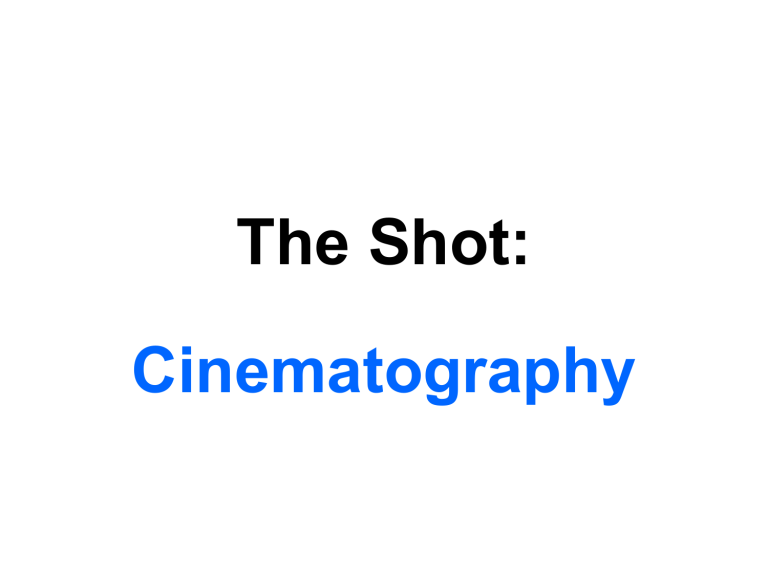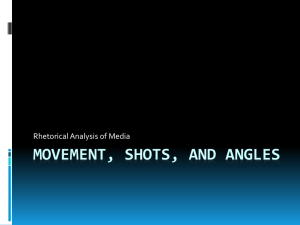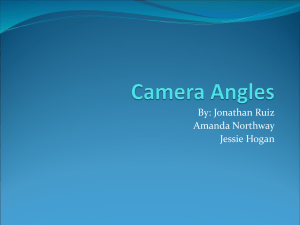The Shot:

The Shot:
Cinematography
The Cinematographer’s
Raw Materials
• Critical flicker fusion (phi phenomenon, persistence of vision – 24 fps)
• Film stock, gauge, format – color vs. BW,
35mm, IMAX, etc.
• Frame – what’s viewable
• Shot – what’s captured by a run of the camera
• Exposure filters & gels to manipulate light & color
Film Stocks
Exposure, Filters
Areas of
Cinematographic Control
1. Photographic aspects of the shot
2. Framing of the shot
3. Duration of the shot
Photographic Aspects of the Shot
Composition
• Symmetry vs. asymmetry (rule of thirds)
• Glass shot – shooting through painted glass
• Superimposition – laying one shot over another
• Projection composite work (rear, front) – green-screen work
• Matte composite work – high-tech copy/paste
• Deep focus – several planes in sharp focus
• Racking focus – pull focus from background to foreground or vise versa
Symmetry, Asymmetry
Superimposition
Projection Composite Work
Matte Composite Work
Deep Focus, Racking Focus
Photographic Aspects of the Shot
Light and Color
• Color timer or grader – person who oversees color in development of film
• Contrast – relations between dark/light
• Tinting – dipping developed film into dye, colors light areas
• Toning – developing film in dye, colors dark areas
• Hand-coloring – painting individual elements within the frame
Tinting, Toning
Hand Coloring
Framing the Shot
The Effects of Framing
A. Size/shape of frame
B. Onscreen/offscreen space
C. Vantage point
D. Movement (mobile framing)
Framing the Shot
A. Size/Shape of Frame
• Aspect ratio (Academy, widescreen, etc.)
• Depth of field (degree of focus available with the camera)
• Focal length
Wide angle (captures great width, distorts edges)
Normal (captures “normal” width, edges have straight lines)
Telephoto (captures great distance, flattens planes)
Zoom (focal length of lens varies)
Depth of Field/Degree of Focus
Wide Angle Shot
Telephoto Shot
Framing the Shot
B. Onscreen/Offscreen Space
• Onscreen space
• Six zones of offscreen space:
Above
Below
Left
Right
In front
Behind
Awareness of Offscreen Space
Framing the Shot
C. Vantage Point: Distance of the Shot
• Seven gradations of camera distance:
Extreme long shot - landscape
Long shot – full human figure, head to toe
Full shot (medium-long or Plan Americain)
– human figure from the knees up
Medium shot – human figure, waist up
Medium close-up – shoulders up
Close-up - face
Extreme close-up – single feature (e.g. eye)
Extreme Long Shot
Long Shot
Full Shot (Medium-Long, P.A.)
Medium Shot
Medium Close-Up
Close-Up
Extreme Close-Up
Framing the Shot
C. Vantage Point: Angle of the Shot
• POV shot – camera “sees” exactly what the character sees
• Upward angle – camera is pivoted vertically on a horizontal axis to “look” up at its subject
• Head-on angle – camera “looks” neither up nor down at its subject
• Downward angle – camera is pivoted vertically on a horizontal axis to “look” down at its subject
• Canted angle – camera “leans” right or left to upset the horizon line
Upward Angle
Head-On Angle
Downward Angle
Canted Angle
Framing the Shot
D. Movement or Mobile Framing
• Pan shot – camera moves horizontally on a vertical axis
• Tilt shot – camera moves vertically on a horizontal axis
• Crane shot – camera is mounted on a crane to shoot from high above the subject
• Tracking shot – camera is mounted on a moving vehicle that follows the subject
• Hand-held/Steadicam – maximum flexibility in the shot
Pan Shot
(Hyperlink)
Tilt Shot
(Hyperlink)
Tracking Shot
(Hyperlink)
Crane Shot
(Hyperlink)
Handheld/Steadicam
(Hyperlink)
Duration of the Shot
The Properties of Time
A.The take
B.Speed of motion
C.Punctuation shots
Duration of the Shot
A. The Take
• Length of take – short, medium, long
• Sequence shot – a single, long take comprising multiple beats and camera movements
Sequence Shot
(Hyperlink)
Duration of the Shot
B. Speed of Motion
• Slow motion – shot at more fps than projected to slow down the movement
• High speed photography – shot at much more fps than projected to achieve an exaggerated slowdown
• Time lapse photography – shot at much fewer fps than projected to speed up the movement
• Ramping – alternating among slow, high and normal speeds
Slow Motion
(Hyperlink)
High-Speed
(Hyperlink)
Time Lapse
(Hyperlink)
Ramping
(Hyperlink)
Duration of the Shot
C. Punctuation Shots
• Fade out – from shot to black
• Fade in – from black to shot
• Dissolve – Shot A fades in as
Shot B fades out
• Freeze frame – film becomes still photo









